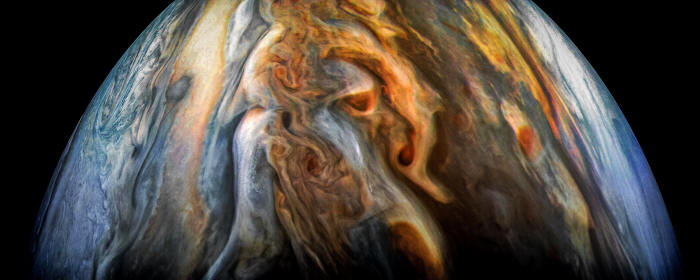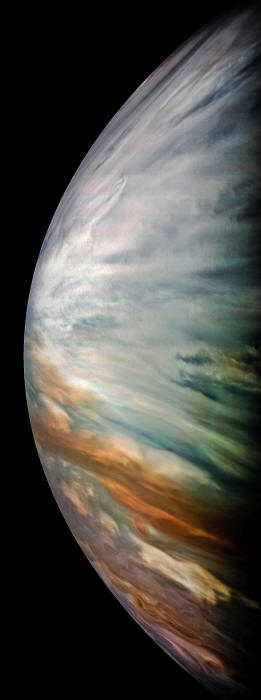|
February 18, 2020 from NASA Website
captured this image of Jupiter's southern equatorial region on Sept. 1, 2017.
The
image is oriented so Jupiter's poles (not visible) run left-to-right
of frame.
Published recently (The Water Abundance in Jupiter's Equatorial Zone) in the journal Nature Astronomy, the Juno results estimate that at the equator, water makes up about 0.25% of the molecules in Jupiter's atmosphere - almost three times that of the Sun.
These are also the first
findings on the gas giant's
abundance of water since the agency's
1995 Galileo mission suggested Jupiter might be extremely dry
compared to the Sun (the comparison is based not on liquid water but
on the presence of its components, oxygen and hydrogen, present in
the Sun).
The leading theories about its formation rest on the amount of water the planet soaked up.
At microwave frequencies, these clouds are transparent, allowing Juno's Microwave Radiometer to measure water deep into Jupiter's atmosphere.
The
image was acquired during Juno's flyby on Dec. 16, 2017.
Water abundance also has important implications for the gas giant's meteorology (how wind currents flow on Jupiter) and internal structure.
While lightning - a
phenomenon typically fueled by moisture - detected on Jupiter by
Voyager and other spacecraft implied the presence of water, an
accurate estimate of the amount of water deep within Jupiter's
atmosphere remained elusive.
The scientists working on
the data were dismayed to find ten times less water than expected.
In a well-mixed atmosphere, the water content is constant across the region and more likely to represent a global average:
When combined with an infrared map obtained at the same time by a ground-based telescope, the results suggested the probe mission may have just been unlucky, sampling an unusually dry and warm meteorological spot on Jupiter.
Because of the Galileo probe experience, the mission seeks to obtain water abundance readings across large regions of the immense planet.
A new kind of instrument for deep space planetary exploration, Juno's Microwave Radiometer (MWR) observes Jupiter from above using six antennas that measure atmospheric temperature at multiple depths simultaneously.
The Microwave Radiometer takes advantage of the fact that water absorbs certain wavelengths of microwave radiation, the same trick used by microwave ovens to quickly heat food.
The measured temperatures
are used to constrain the amount of water and ammonia in the deep
atmosphere, as both molecules absorb microwave radiation.
From its orbital perch, the radiometer was able to collect data from a far greater depth into Jupiter's atmosphere than the Galileo probe - 93 miles (150 kilometers), where the pressure reaches about 480 psi (33 bar).
The science team is eager
to see how atmospheric water content varies by latitude and region,
as well as what the cyclone-rich poles can tell them about the gas
giant's global water abundance.
The next science flyby takes place on April 10, 2020.
NASA's Jet Propulsion Laboratory (JPL) in Pasadena, California, manages the Juno mission for the principal investigator, Scott Bolton, of the Southwest Research Institute in San Antonio.
Juno is part of NASA's New Frontiers Program, which is managed at NASA's Marshall Space Flight Center (MSFC) in Huntsville, Alabama, for NASA's Science Mission Directorate.
The Italian Space Agency contributed the Jovian Infrared Auroral Mapper (JIRAM) and the Ka-Band translator system.
Lockheed Martin Space in
Denver built and operates the spacecraft.
|



